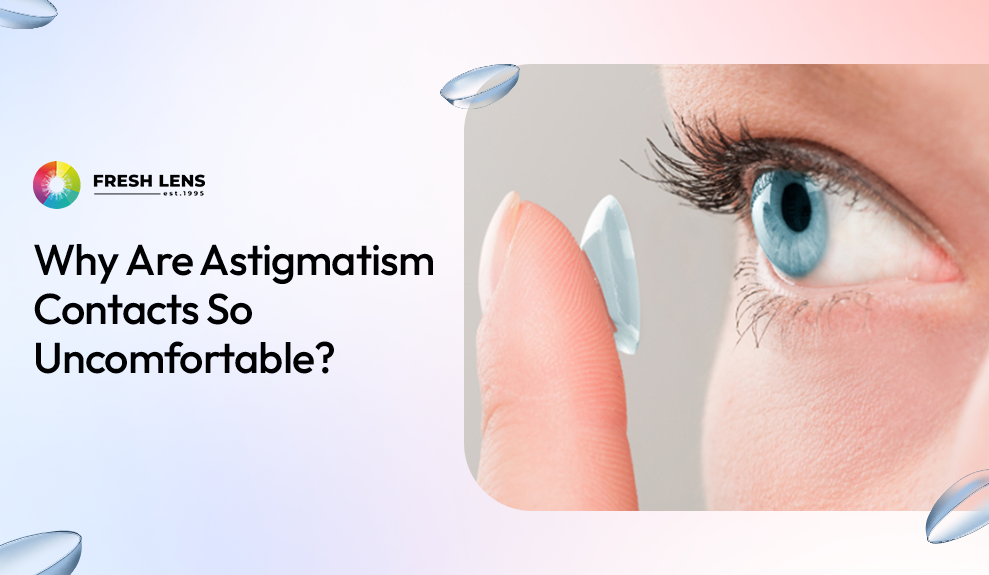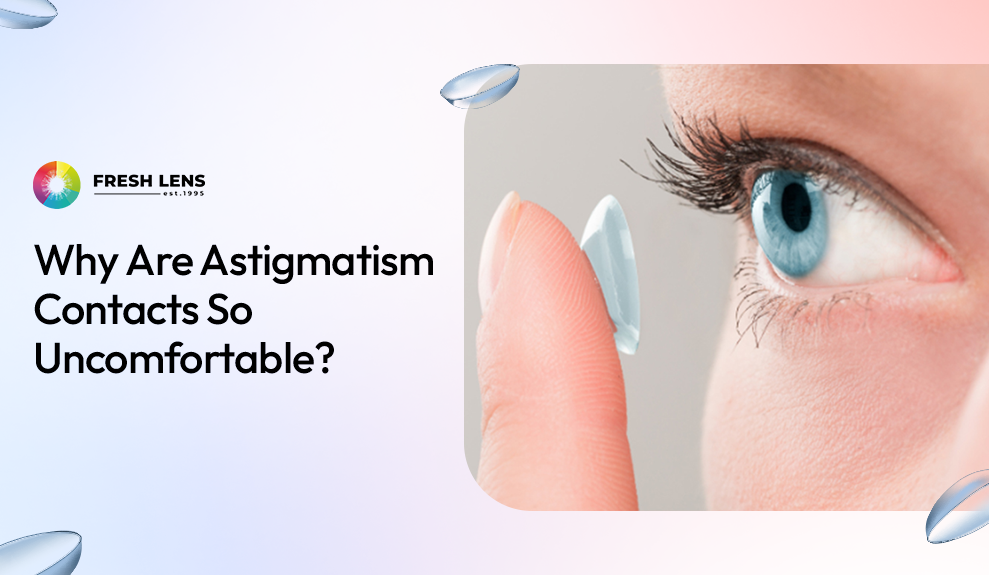
If you’ve recently switched to astigmatism contacts, you might have found yourself wondering, Why do these lenses feel so uncomfortable? You’re not alone. For many people, adjusting to toric lenses can feel like an uphill climb. The good news? It doesn’t have to stay that way. In this guide, we’ll break down the reasons behind the discomfort, provide solutions to make your lenses more bearable, and share practical tips for better eye care.
The Unique Challenge of Astigmatism Contacts
Astigmatism is a common vision issue caused by an irregularly shaped cornea or lens inside the eye. Unlike nearsightedness or farsightedness, astigmatism requires a unique correction. Enter toric lenses, designed specifically for people with astigmatism.
Unlike regular contacts, toric lenses have different prescriptions in different parts of the lens and are weighted to stay in a specific position on your eye. While this design helps correct vision issues with astigmatism, it can also lead to some unique challenges:
- Uneven Lens Pressure: Toric lenses rely on gravity to maintain their position. If the lens rotates, your vision might blur temporarily. This constant adjustment can lead to contact lens irritation.
- Sensitive Eyes and Lenses: People with astigmatism often have more sensitive eyes, which can make them more prone to feeling discomfort.
- Proper Lens Fit Matters: A poorly fitted lens can exacerbate irritation and lead to significant contact lens discomfort.
Adding to the complexity, the level of discomfort can vary depending on the severity of astigmatism, environmental factors, and individual eye sensitivities. While it’s normal to feel frustrated, it’s essential to understand the root causes so you can find the right solutions.
Why Do Toric Lenses Feel Uncomfortable?
If you’re experiencing discomfort with toric lenses, here are some of the common culprits:
-
The Lens Fit Is Off
Toric lenses come in various sizes and shapes. Even a slight misfit can create irritation, dryness, or blurred vision. A better fit for toric contacts often resolves these issues. Consult your optometrist to ensure your lenses are custom-fit for your eyes. -
Dry Eyes
Lack of moisture is one of the leading causes of discomfort. This can be especially problematic for those who spend a lot of time in air-conditioned spaces or staring at screens. Using drops specifically designed for contact lens hydration can help. Studies have shown that screen time significantly reduces blinking rates, which worsens dryness in lens wearers. -
Adjustment Period
Even with the perfect fit, it takes time to adjust to astigmatism contacts. Your eyes need to adapt to the lens’ weight and movement. The typical adjustment period can range from a few days to a couple of weeks, depending on individual sensitivity. -
Lens Rotation
If your toric lenses don’t stay in place, it can lead to blurred vision and discomfort. This is a common issue as toric lenses are weighted to sit correctly, but external factors like blinking or eye shape can cause them to shift. This can often be fixed with astigmatism correction options tailored to your needs. -
Improper Cleaning and Care
Dirty lenses or using the wrong cleaning solution can cause irritation and discomfort. Proper eye care is essential for comfortable contact lens wear. Make sure you’re following the cleaning instructions provided by your eye care professional and replacing your lenses as recommended. -
Environmental Factors
Windy weather, exposure to dust, and prolonged time in dry environments can exacerbate discomfort. Wearing protective glasses outdoors can reduce the impact of these external elements on your lenses.
Tips to Adjust to Astigmatism Contact Lenses
-
Get the Right Prescription
Consult an eye care professional to ensure you’re using the best contact lenses for severe astigmatism. A custom fit can make all the difference. Regular follow-ups can also help address any emerging issues early on. -
Hydrate Your Lenses
Invest in high-quality lens solutions that prioritize hydration. This reduces dryness and irritation. Some advanced lens solutions even include moisture-locking agents for extended comfort. -
Blink More Often
It sounds simple, but blinking refreshes your eyes and redistributes moisture—especially important during long screen sessions. If you’re spending hours working on a computer, consider using the 20-20-20 rule: every 20 minutes, look at something 20 feet away for 20 seconds to rest your eyes. -
Ease Into Wearing Them
Start with shorter periods and gradually increase wear time. This helps your eyes adjust to the uneven lens pressure without overwhelming them. -
Keep Them Clean
Regular cleaning prevents the buildup of debris and bacteria, which can worsen contact lens discomfort. Remember to replace your lens case every three months to avoid contamination. -
Explore Low-Cost Solutions
If comfort remains an issue, talk to your optometrist about free or low-cost trials for different lens brands. Many companies offer samples to help you find the right fit. This is a great way to test premium options without committing financially upfront.
When to See a Professional
If your discomfort persists despite your best efforts, don’t hesitate to consult an eye care professional. They can help pinpoint the issue, whether it’s an improper fit, an undiagnosed condition, or simply the need for a different type of lens. Regular eye exams are critical for detecting any underlying issues early on.
Adjusting to astigmatism contacts can be challenging, but with the right eye care, proper lens fit, and patience, comfort is achievable. Global Lens is here to support you with resources and guidance to make your contact lens journey smoother.
Your eyes deserve the best care, and small steps like improving hydration, exploring alternative lenses, or consulting a professional can make all the difference. Clear and comfortable vision is within your reach, don’t hesitate to seek help if needed. Global Lens is committed to helping you see the world clearly and comfortably.

































